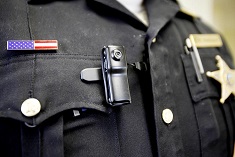Evaluating the Impact of Officer Worn Body Cameras in the Phoenix Police Department

The Bureau of Justice Assistance (BJA), through the SMART Policing Initiative (SPI), awarded the Phoenix Police Department $500,000 to purchase, deploy and evaluate police body worn cameras. The design and implementation of the project included the purchase of 56 BWC systems and deploying them in the Maryvale Precinct. The implementation of the BWC’s occurred in one of the two Maryvale Precinct squad areas (aka target area). All officers assigned to the target area were issued the equipment and were provided training in its use, maintenance, and related departmental policy. This evaluation was conducted to examine the effect of implementing police worn body cameras on complaints against the police and domestic violence case processing and outcomes.
Our analysis of the camera meta-data indicated that only 13.2 to 42.2 percent of incidents were recorded by and BWV camera. Domestic violence incidents were the most likely to be recorded (47.5%), followed by violent offenses (38.7), back-up (37%), status offenses (32.9%), and subject/vehicle stops (30.9%). Other offense types were recorded less often. While in general the technology was found to be comfortable and easy to use, officers were dissatisfied with long down load times, increased amount of time that it took to complete reports, and the possibility that video recordings might be used against them by the department. We also found that video submitted to the court was difficult to process because of logistical problems associated with chain of custody and the length of time that it took the prosecutors to review video files. While many of the problems were addressed by the precinct commander by assigning a police officer to serve as a court liaison officer, prosecutors still maintained that they did not have enough time to review video footage.
Regardless, the officer worn body cameras were found to be beneficial to the officers and the court in a number of ways. First, officer productivity as measured through the number of arrests increased significantly. For instance, the number of arrests increased by about 17% among the target group compared to 9% in the comparison group. Second, complaints against the police declined significantly. Complaints against officers who wore the cameras declined by 23%, compared to a 10.6% increase among comparison officers and 45.1% increase among patrol officers in other precincts. Third, our data showed that those officers who wore cameras and received a complaint were significantly less likely to have the complaint sustained when compared to the comparison group and other patrol officers throughout the PPD. This suggests that even if a complaint was made against a camera wearing officer the video file was likely to provide support to the officer. Fourth, and related, the officer self-report data suggested that a significant number of complaints were not pursued because of video recordings. BWC did not appear, however, to have an impact on suspect behavior as measured through resisting arrest charges.
Additionally, we examined the impact of body worn cameras on domestic violence case processing. Analysis of the data indicated that following the implementation of body cameras, cases were significantly more likely to be initiated, result in charges filed, and result in a guilty plea or guilt verdict. The analysis also determined that cases were completed faster following the implementation of body cameras, however, we believe that this finding was largely a product of the addition of a court liaison officer who facilitated case processing between the PPD and city prosecutors office.
Documents:
|
|